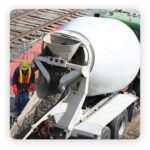
By Jessica Kim, Head of Marketing & Revenue Operations at Pitstop
February 28, 2024
In the bustling fleet industry, fleet managers are tasked with a multitude of responsibilities, from ensuring vehicles are operating efficiently to optimizing routes and schedules. However, in recent years, the influx of data has presented both opportunities and challenges for fleet managers. The sheer volume of data generated by vehicles can be overwhelming, and the need to navigate through multiple dashboards and solutions only adds to the complexity.
In this blog, we’ll explore how vehicle data has become more of a burden than a benefit for fleet managers when dealing with fragmented information, calling upon a specific customer within the building materials industry. And how anyone with vehicle data can leverage predictive maintenance solutions like Pitstop to streamline their operations, save precious time and unlock the full potential of their fleet operations.
The Data Flood: A Challenge for Fleet Managers
In today’s digital age, vehicles are equipped with sensors and telematics systems that generate 1.4 TB and 19 TB of data per hour on  everything from engine performance to fuel consumption. While this data holds valuable insights that can improve fleet efficiency and reduce costs, it can also overwhelm fleet managers who struggle with having enough time in their day to decide what is useful for their critical tasks.
everything from engine performance to fuel consumption. While this data holds valuable insights that can improve fleet efficiency and reduce costs, it can also overwhelm fleet managers who struggle with having enough time in their day to decide what is useful for their critical tasks.
One of the primary challenges faced by fleet managers is the fragmentation of data across various platforms and systems. Instead of having a unified view of their fleet operations, they often find themselves toggling between multiple dashboards and solutions, each providing only a partial picture of their vehicles’ performance.
The Pitfalls of Multiple Logins
Having to juggle multiple logins and interfaces not only wastes valuable time but also increases the likelihood of errors and oversight. Fleet managers may miss critical maintenance alerts or fail to identify patterns and trends that could help them preemptively address issues before they escalate.
Moreover, the disjointed nature of existing solutions makes it difficult to derive actionable insights from their data. Without a comprehensive understanding of their vehicles’ health and performance, they are forced to adopt a reactive approach to maintenance leading to costly downtime, which on average for a heavy-duty vehicle, can begin anywhere from $150 per hour and up, not to mention the higher cost of unplanned repairs or replacements.
 One leading building materials company with over 600 assets which produces ready-mix concrete and asphalt, and also offers paving and construction services, was dealing with a mismatched process of information across their fleet. On top of isolated maintenance systems, the fleet was juggling service records mileage data and scanner mileage data, unlogged information through calls between drivers and road mechanics, and utilizing manual vehicle inspection processes. This was all leading to considerable inefficiencies across their fleet operations – a serious headache for any fleet supervisor.
One leading building materials company with over 600 assets which produces ready-mix concrete and asphalt, and also offers paving and construction services, was dealing with a mismatched process of information across their fleet. On top of isolated maintenance systems, the fleet was juggling service records mileage data and scanner mileage data, unlogged information through calls between drivers and road mechanics, and utilizing manual vehicle inspection processes. This was all leading to considerable inefficiencies across their fleet operations – a serious headache for any fleet supervisor.
A Unified Solution: Leveraging Predictive Maintenance with Pitstop
Enter Pitstop, a predictive maintenance platform designed to empower fleet managers with actionable insights derived from their vehicle data. By consolidating disparate data sources into a single, intuitive dashboard, Pitstop enables fleet managers to gain a comprehensive view of their fleet operations and make informed decisions in real-time. “I want to have all the important information in one place. It’s hard to go on telematics and other software on a daily basis,” said the building material company’s Shop Manager.
 For the building materials company that was managing this manual process across multiple shops, having one source of truth would seem remarkably significant for their fleet performance. Utilizing predictive maintenance allowed them to unlock nearly $300,000 in annual savings across their 600-assets, a 460% ROI, simply by streamlining their maintenance workflow and alerting their mechanics to probable issues prior to receiving the vehicles – avoiding unnecessary downtime or repeat visits to the shop.
For the building materials company that was managing this manual process across multiple shops, having one source of truth would seem remarkably significant for their fleet performance. Utilizing predictive maintenance allowed them to unlock nearly $300,000 in annual savings across their 600-assets, a 460% ROI, simply by streamlining their maintenance workflow and alerting their mechanics to probable issues prior to receiving the vehicles – avoiding unnecessary downtime or repeat visits to the shop.
With fleet maintenance software powered by AI, fleet managers no longer need to waste time logging into multiple systems or manually aggregating data from different sources. Instead, they can access comprehensive vehicle health reports and analytics that highlight potential maintenance issues, prioritize fault codes with easy-to-read descriptions powered by ChatGPT, and automate the flow of data between historical work order information, as well as telematics. When time correlates to dollars saved in this supply-constrained world, a Director of Fleet mentioned, “Pitstop automates data passing between our telematics and maintenance systems, helping us get work done faster.”
With easy cross-functional sharing and export options, a fleet manager can send reports directly to shops or vendors, ensuring vehicles are fixed right the first time to optimize individual vehicle performance and save over 10 hours of diagnostic time per week.
Getting Started with Predictive Maintenance
 For many fleet managers who are putting out daily fires, it can seem like an added burden to set up an additional solution, even if you are aware of its benefits. That’s why the right fleet maintenance software should focus not just on the overall ROI for the company, but the implementation for the fleet team. For example, Pitstop ensures a smooth onboarding process so customers can be up and running within ten minutes. With weekly or biweekly training and check-ins within the first few months, the Pitstop team ensures you are set up for success so that the software is not just adopted but embraced to become an integral part of your maintenance operations.
For many fleet managers who are putting out daily fires, it can seem like an added burden to set up an additional solution, even if you are aware of its benefits. That’s why the right fleet maintenance software should focus not just on the overall ROI for the company, but the implementation for the fleet team. For example, Pitstop ensures a smooth onboarding process so customers can be up and running within ten minutes. With weekly or biweekly training and check-ins within the first few months, the Pitstop team ensures you are set up for success so that the software is not just adopted but embraced to become an integral part of your maintenance operations.
While data may have initially posed a challenge, solutions like Pitstop are transforming the way they approach maintenance and operations. By centralizing data management and harnessing the power of predictive analytics, fleet managers can turn what was once a burden into a competitive advantage, driving efficiency, and profitability across their organizations.





